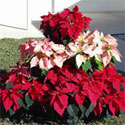Major Postproduction Issues
Bract Edge Burn
Bract edge burn may cause serious problems in the final weeks of production or following boxing and transport. Bract Edge Burn became a major problem in the late 1970s with the introduction of Gutbier V-14 Glory produced in southern climates. Over the last 10 years, it has become evident that BEB is cultivar-dependent. Bract edge burn symptoms vary among cultivars, but most begin as lesions that serve as points of infection by Botrytis, which will spread and make plants unmarketable. More...
Lateral Stem Breakage
Lateral stem breakage can become a problem at shipping time when one or more lateral stems break as plants are removed from the bench for sleeving. It can also occur during and/or after sleeving. The most sensitive plants are those with lower laterals that grow perpendicular to the stem. These laterals break off easily, which can limit the plant's marketability and economic value.
Many factors contribute to a plant's susceptibility to lateral stem breakage, but the most significant has been shown to be the cutting diameter at planting. Research has shown that cuttings 4.5 mm in diameter or less have twice as much breakage compared to cuttings with a diameter of 7.5 mm or greater. Careful grading of cuttings and use of adequate numbers of stock plants to obtain high quality, thick cuttings is well worth the work to prevent what can be a significant economic loss due to lateral stem breakage.
Plant spacing and fertilization are two other factors contributing to lateral stem breakage. Plants grown with inadequate space or with improper fertilizer type/formulation were found to be more prone to stem breakage, especially if thin cuttings were used. The use of 300 ppm N from KNO3 and (CaNO3)2, due to the presence of calcium, reduced stem breakage when compared to 300 ppm N from Peters 20-10-20. The addition of calcium (244 ppm) in the fertilizer combined with thick diameter cuttings actually eliminated lateral stem breakage and produced more plants with upright lateral growth.
As always, the careful selection of appropriate poinsettia varieties and the maintenance of the proper cultural environment are indispensable to crop success.

